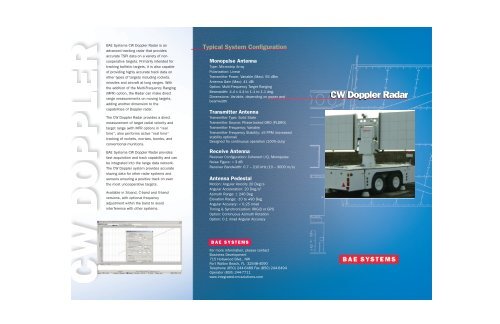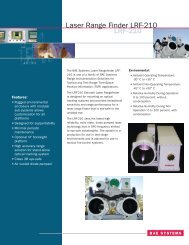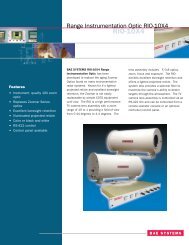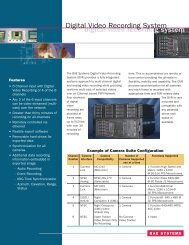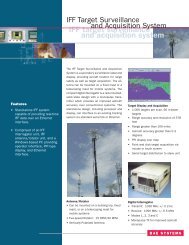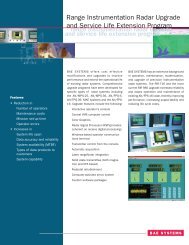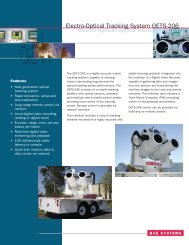CW Doppler Tri-Fold (.pdf) - ESD Radar - Home
CW Doppler Tri-Fold (.pdf) - ESD Radar - Home
CW Doppler Tri-Fold (.pdf) - ESD Radar - Home
- No tags were found...
You also want an ePaper? Increase the reach of your titles
YUMPU automatically turns print PDFs into web optimized ePapers that Google loves.
BAE Systems <strong>CW</strong> <strong>Doppler</strong> <strong>Radar</strong> is an<br />
advanced tracking radar that provides<br />
accurate TSPI data on a variety of noncooperative<br />
targets. Primarily intended for<br />
tracking ballistic targets, it is also capable<br />
of providing highly accurate track data on<br />
other types of targets including rockets,<br />
missiles and aircraft at long ranges. With<br />
the addition of the Multi-Frequency Ranging<br />
(MFR) option, the <strong>Radar</strong> can make direct<br />
range measurements on moving targets,<br />
adding another dimension to the<br />
capabilities of <strong>Doppler</strong> radar.<br />
The <strong>CW</strong> <strong>Doppler</strong> <strong>Radar</strong> provides a direct<br />
measurement of target radial velocity and<br />
target range (with MFR option) in “real<br />
time”; also performs active “real time”<br />
tracking of rockets, mortars, bombs, and<br />
conventional munitions.<br />
BAE Systems <strong>CW</strong> <strong>Doppler</strong> <strong>Radar</strong> provides<br />
fast acquisition and track capability and can<br />
be integrated into the range data network.<br />
The <strong>CW</strong> <strong>Doppler</strong> system provides accurate<br />
slaving data for other radar systems and<br />
sensors ensuring a positive track on even<br />
the most uncooperative targets.<br />
Available in S-band, C-band and X-band<br />
versions, with optional frequency<br />
adjustment within the band to avoid<br />
interference with other systems.<br />
Typical System Configuration<br />
Monopulse Antenna<br />
Type: Microstrip Array<br />
Polarization: Linear<br />
Transmitter Power, Variable (Max): 55 dBm<br />
Antenna Gain (Max): 41 dBi<br />
Option: Multi-Frequency Target Ranging<br />
Beamwidth: 4.4 x 4.4 to 1.1 to 1.1 deg.<br />
Dimensions: Variable, depending on power and<br />
beamwidth<br />
Transmitter Antenna<br />
Transmitter Type: Solid State<br />
Transmitter Source: Phase-locked DRO (PLDRO)<br />
Transmitter Frequency: Variable<br />
Transmitter Frequency Stability: ±5 PPM (increased<br />
stability optional)<br />
Designed fro continuous operation (100% duty)<br />
Receive Antenna<br />
Receiver Configuration: Coherent I/Q, Monopulse<br />
Noise Figure: < 3 dB<br />
Receiver Bandwidth: 0.7 – 210 kHz (10 – 3000 m/s)<br />
Antenna Pedestal<br />
Motion: Angular Velocity 20 Deg/s<br />
Angular Acceleration: 20 Deg/s 2<br />
Azimuth Range: ± 240 Deg<br />
Elevation Range: -10 to +90 Deg<br />
Angular Accuracy: < 0.25 mrad<br />
Timing & Synchronization: IRIG-B or GPS<br />
Option: Continuous Azimuth Rotation<br />
Option: O.1 mrad Angular Accuracy<br />
For more information, please contact<br />
Business Development<br />
715 Hollywood Blvd., NW<br />
Fort Walton Beach, FL 32548-4090<br />
Telephone (850) 244-6489 Fax (850) 244-6494<br />
Operator (850) 244-7711<br />
www.integrated-om-solutions.com
BAE Systems <strong>CW</strong> <strong>Doppler</strong> <strong>Radar</strong><br />
Competitive Advantages:<br />
• Mobility – available in trailered configurations – can be<br />
operational in one hour<br />
• Fully remote operations via fiber optic or R.F links<br />
• Full system documentation<br />
• Built using the latest commercially available technology<br />
• Complete system life cycle support – hardware and software<br />
updates<br />
• Custom data formats – system integrated into existing range<br />
data networks<br />
• Frequency options – S, C and X-band<br />
• Continuous “on” operation – superior system cooling allows<br />
continuous operation in extreme environments<br />
• Open bus and data structure – enables future upgrades and<br />
customer specified/designed enhancements<br />
• Customer focused design solutions – tailored power levels,<br />
accuracy, configuration and options<br />
• Superior support after the sale – on-line help desk, warranty and<br />
spares<br />
• Operator friendly controls with real-time displays, minimal<br />
training required with built in calibration and test<br />
• Quick look data and post-mission data processing – data<br />
available within minutes<br />
• Easily customer tailored data reports and plots<br />
• Global company with a presence in over 130 countries and more<br />
the 100,000 employees<br />
• ISO -9001 certified<br />
why buy<br />
<strong>CW</strong> <strong>Doppler</strong><br />
• Highly mobile systems with rapid set-up<br />
• Fully remote operations<br />
• Provides direct precision velocity measurement<br />
• Provides a full tracking solution (angles and<br />
range)<br />
• Fast target acquisition and track – less than 0.5<br />
seconds<br />
• Capability to slave other range sensors<br />
• Automatic collection of raw data on all targets in<br />
the beam<br />
• Post processing provides spin data, multiple<br />
target TSPI, and debris characterization<br />
• Self calibration and built in test<br />
• High sample rate ensures unambiguous <strong>Doppler</strong><br />
velocity measurements on all targets in the beam<br />
• Sophisticated processing hardware integrated with the radar<br />
antenna and pedestal<br />
- 16-channel Analog/Digital Converter (ADC) with integral antialiasing<br />
filter: 8 I/Q channel pairs sampled simultaneously<br />
- 92 dB dynamic range (16-bit digitizer)<br />
- IRIG-B or GPS time synchronization<br />
- Power PC-based Digital Signal Processor (DSP) with real-time os<br />
- Available memory: 1.5 GByte Ram, unlimited direct-to-disk<br />
- Open PC architecture allows the addition of DSP hardware to<br />
increase FFT size and speed of the returned <strong>Doppler</strong> signal<br />
(<strong>Doppler</strong> frequency) and for the calculation of the Power<br />
Spectral Density (PSD)<br />
- Operating temperature from -30 degree to +50 degree C<br />
- Storage temperature from -40 to +65 C<br />
- FFT (Fast Fourier Transform) algorithm for extracting the<br />
frequency velocity<br />
- Power supply at 120/240 VAC +/-15%, 50/60 Hz<br />
• Variable sample rate and anti-alias filter<br />
• Variable and adaptive FFT size from 32 to 8K samples, real-time<br />
• Timing accuracy: 1/16 sample or 25 ppm<br />
• <strong>Tri</strong>gger source: manual, or external (acoustic, optical, TTL,<br />
analog)<br />
• Processing software:<br />
- Real-time signal processing and radar control<br />
- FFT size up to 8192 pts (Power PC-based processing)<br />
- Ranging capability using multiple transmitter frequencies<br />
- Built-in Velocity Calibration<br />
• Direct measurement in real time:<br />
- <strong>Doppler</strong> signal vs time<br />
- Radial velocity, distance, azimuth angles and elevation of the<br />
target, and signal-noise ratio as function of time<br />
• Computed data:<br />
- Velocity, radial acceleration, and signal-to-noise ratio as a<br />
function of distance and time<br />
- 3-D trajectory:<br />
Vertical and horizontal trajectory as a function of distance<br />
- Computed accuracy for each round based on actual measured<br />
data<br />
• Post-mission products:<br />
- Advanced report generation using MS Excel (default or user<br />
defined templates)<br />
- Integrated journal for logging all parameters and results for<br />
each round<br />
- The system will supply the following data:<br />
Post analysis results, Velocity measurements, Repetitive<br />
fire (burst mode) data and Trajectory analysis<br />
• Analysis Models:<br />
- Real-time tracking: STANAG 4355 Modified Point Mass Model<br />
- Ballistic coefficients analysis: MPM (4 DOF) ballistic model<br />
calibration using tracking data<br />
- Trajectory prediction: MPM (4 DOF) ballistic model<br />
• Pentium-based PC computer running Windows<br />
• Networked with the <strong>Doppler</strong> processor using a high-speed optical link<br />
• Operator interface (GUI) for the <strong>Doppler</strong> processor<br />
- Real-time velocity spectrum, A-scope, and boresight angle display<br />
- Graphical target identification, designation and tracking<br />
- On-line FFT size and tracking window control<br />
- Independent velocity, range, azimuth and elevation tracking<br />
- Transmitter output power control for manual or preprogrammed<br />
sequential mode<br />
• Data display unit:<br />
- Peak spectrogram<br />
- <strong>Doppler</strong> waterfall<br />
- Modulation frequency and signal-to-noise ratio vs time<br />
- Range vs time and angle vs time<br />
•Operation:<br />
- Multiple test configuration definitions (user defined)<br />
- Raw data recorded for all channels<br />
- Post-processing for further data reduction and analysis<br />
- Multiple target tracking (postprocessing)<br />
- Advanced graphical data<br />
representation, tools, and<br />
report generation using<br />
Microsoft Excel templates<br />
- Provides and accepts<br />
designate data<br />
• Primary data output<br />
- Velocity, azimuth and elevation<br />
• Secondary output<br />
- Time scale: Relative and/or absolute time<br />
- Computed acceleration and position<br />
- Radial velocity (both negative and positive velocities)<br />
- Radial distance (integrated velocity, multi-frequency ranging)<br />
- Monopulse and target azimuth and elevation angles<br />
- Signal-to-noise ratio (SNR)<br />
- <strong>Doppler</strong> frequency (velocity) spectrum


